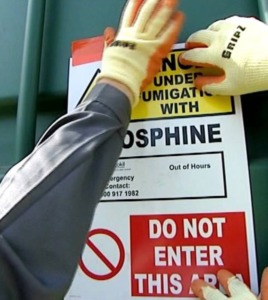GRAIN FUMIGANT HAZARDS
Phosphine has been used in the fumigation of grain storage structures since 1958. Available formulations include aluminum or magnesium phosphide. Both penetrate deeply into stored grain killing target pests. While licensed fumigators are highly trained in phosphine’s hazards, many affected employees and contractors working in close proximity to fumigated structures are not. This blog provides basic information for anyone working near structures fumigated with aluminum or magnesium phosphide.

Odor and Toxicity
Phosphine has an odor that is often compared to dead fish or garlic. The odor can be detected at low concentrations but should not be relied upon for warning purposes. Phosphine also has a specific gravity in air of 1.214 (air=1 @ standard temperature and pressure). Since phosphine is heavier than air it penetrates deep into grain. This also means that phosphine can settle in low lying interior areas lacking adequate natural or mechanical ventilation such as tunnels, basements, and boot pits.
Phosphine gas is generated when aluminum or magnesium phosphide is exposed to heat or moisture. Phosphine gas at certain levels can be toxic to humans. The Occupational Safety and Health Administration (OSHA) sets the Permissible Exposure Level (PEL) for phosphine at 0.3 parts per million (ppm). The PEL is the highest level of exposure an employee may be exposed to without incurring the risk of adverse health effects based on an eight-hour workday. Exposure to concentrations above the PEL requires NIOSH certified respiratory protection, such as a full-face respirator with an appropriate canister or cartridge.
Symptoms
Symptoms of low-level exposure to phosphine may include general fatigue, ringing in the ears, nausea, or pressure in the chest. These symptoms may occur immediately or several hours after exposure. Symptoms of exposure to greater quantities of phosphine may include fatigue, nausea, vomiting, diarrhea, and chest pain. Symptoms should disappear when the exposed person is removed to an area with fresh air. Should symptoms persist, the person should receive immediate medical attention.
Notifications
Employees working near fumigated structures must be notified that fumigation is in process. This can be accomplished by conducting routine safety meetings and placarding fumigated structures. The licensed applicator is required to post placards or signs at the entrances to the fumigated structure and areas connected to the structure. These placards and signs warn affected employees of potential danger and the need to stay out of the area. Unauthorized persons should not have access to fumigated areas.
Fumigation Process
Once the fumigation process is complete the fumigator will ensure that the structure is adequately aerated so that affected persons are not exposed to residual phosphine. Areas adjacent to bins, silos, or fumigated structures should be ventilated using natural or mechanical ventilation. This can be achieved by leaving tunnel access hatches, windows, and doors open or by providing artificial ventilation with fans or blowers. Employees should be encouraged to use air monitoring equipment when entering recently fumigated areas. Monitoring for phosphine can be performed by using gas detector tubes or an air monitor equipped with phosphine sensing capability. Employees must never re-enter structures until the concentration of phosphine is less than its PEL (0.3 ppm).
Fumigant tablet canisters should be stored in a dry place protected area. Exposure to water or other liquids releases phosphine gas and may cause spontaneous ignition. The fumigant storage area should also be properly labeled. An NFPA diamond label on the exterior of the storage area will assist first responders by communicating basic hazard information.
Remember, safety doesn’t have to be difficult, simple steps, such as training employees on fumigant hazards and how they can protect themselves, can prevent exposure and send people home safely.
Related blog articles:
- Confined Space Incidents
- Hierarchy of Controls
- Effective Workplace Communication Guide
- Full Course Catalog – Safety Made Simple
Joe Mlynek is a partner and subject matter expert at Safety Made Simple, LLC. He has over 20 years of experience in safety at the corporate level and as a consultant. He is a Certified Safety Professional (CSP) and Occupational Safety and Health Technician (OHST). Joe can be reached at joe.mlynek@safetymadesimple.com
